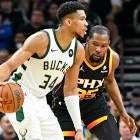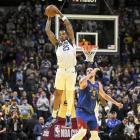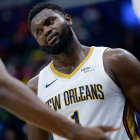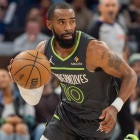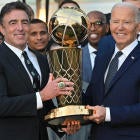After making his second All-Star team, winning his first playoff series, taking two games from the eventual NBA champions in the conference finals, signing a $138 million contract and winning a gold medal at the Olympic Games, DeMar DeRozan came back to the Toronto Raptors a different player. Yes, he is still a score-first shooting guard who mostly operates inside the 3-point line, but watching him this year has been a mind-bending experience for some. Take Haralabos Voulgaris, a professional NBA gambler who has been critical of DeRozan's throwback, midrange-focused style in the past:
DeMar DeMidrange is my new favorite player. Not even kidding.
— Haralabos Voulgaris (@haralabob) November 16, 2016
DeRozan is the Copernicus of his time. He's making me question everything I've believed in.
— Haralabos Voulgaris (@haralabob) November 16, 2016
Three weeks into his eighth season, DeRozan is leading the league in scoring by averaging 33.3 points on 50.6 percent shooting. He has two 40-point games already and has only made six 3-pointers in 406 minutes. This is the kind of thing that wasn't supposed to happen in the modern NBA.
"I'm a very rebellious person," DeRozan said Tuesday, via the Toronto Sun's Ryan Wolstat. "When somebody tells me I can't do something, I'ma do it just to show you it can be done. The cool thing I find is when I see people say, 'The midrange game is not dead.' That's the cool thing for me because I never let nobody tell me how I should play basketball. If I can get it done, if anybody can get it done any type of style, that's all that matters."
Toronto deserves some credit for sticking with DeRozan all these years rather than forcing him to change his game when he wasn't scoring efficiently. This wouldn't have worked, though, if DeRozan wasn't so dedicated. Long praised for his work ethic, DeRozan has been gradually building toward this scoring explosion his entire career. The shots that are most difficult for the vast majority of NBA players -- contested ones, off the dribble, in traffic -- now appear to be easy for him.
"It's like Neo in The Matrix," DeRozan said this week, via TSN's Josh Lewenberg. "I watch so much film. I study so much -- every angle, every defensive coverage, every opponent. Even nights before games understanding if there's going to be a big guy or a smaller guy on me. Just really getting mentally prepared that way just sets it all up differently when I go out there and play."
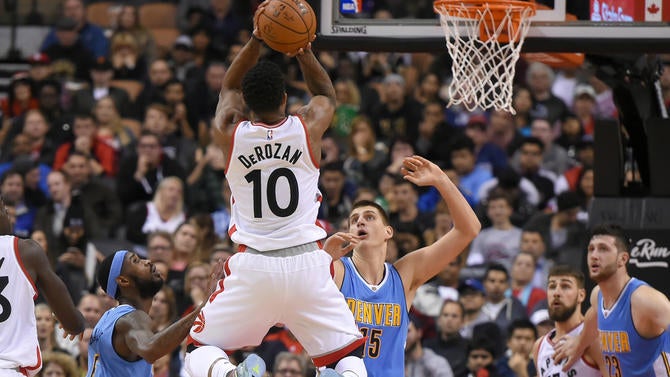
How crazy are the shots DeRozan is making? And just how in the world is he making them consistently? Let's have a look:
Creating space better than ever
On Tuesday, Golden State Warriors forward Kevin Durant told reporters that DeRozan had "probably the best footwork I've seen in a long time," via the San Jose Mercury News' Anthony Slater. DeRozan is not blessed with Durant's height or long arms, so he can't just rise up over his defender and shoot as easily. This means he needs ways to separate himself, and he has a bunch of tricks in his bag.
One of DeRozan's best new tricks: A smooth step to the side. Look at what he does when matched up against the longer Rudy Gay, a former teammate:
DeRozan's recent play has drawn comparisons to Kobe Bryant and Dwyane Wade, and he has studied them both, but this is more of a Stephen Curry move. One second, Gay is right there; the next, DeRozan is getting his shot off cleanly. He has used that particular gather in a couple of different clutch situations, including this crucial possession in Washington:
It helps, also, that DeRozan only needs a sliver of space. Here, he goes to the stepback, hits Andre Roberson with a pump fake and then banks it in:
That's a classic "bad shot" -- he went one-on-one against a solid wing defender, and launched it at the end of the shot clock with a hand in his face. DeRozan was patient the entire time, though, and released it comfortably. How demoralizing.
A reliable left hand
In the summer of 2014, DeRozan decided to eat all his meals with his left hand. He wrote with his left hand, too, even if it wasn't particularly legible. He might have looked silly then, but it has paid off on the court, like when he split this double-team in Charlotte and banked it in:
In that same game, DeRozan went to a lefty finish out of the post. Had he used his strong hand, Cody Zeller might have blocked this shot:
That probably wasn't in the scouting report, and that's the point. Defenders have not been ready for DeRozan's array of moves, and being able to finish with either hand has multiplied his options around the basket.
An attacking mentality
In 2015, DeRozan told ESPN's Mike Mazzeo that the biggest misconception of his game is that he can't shoot 3-pointers. He insisted that he could shoot from long range more often if he wanted to -- he would just rather go to the hole.
"I don't shoot 3s because I choose not to shoot 3s," DeRozan said. "If I shoot them, I know I can make them. I feel like every time I get the ball I can get to the rim or I can get fouled. That's just what my mindset is."
That attacking mentality is apparent when watching some of DeRozan's drives, and it means that his defender can never relax. Here, Roberson and big man Domantas Sabonis are both trying to keep him away from the paint, but he keeps his dribble alive, shields the ball with his body and waits for his chance to make a simple (for him) floater:
Here, he again decides he's getting inside by any means necessary:
The spacing isn't perfect, the Hornets are trying to take away the driving lane and he just gets there anyway. Pay attention to his between-the-legs dribble from left to right, and then remember that, a couple of years ago, people called his ballhandling a weakness. More on that later.
Impeccable balance on in-between shots
DeRozan's leaners and floaters allow him to score from pretty much anywhere inside the arc. It's hard to guard a guy who can race down the court, hit you with an inside-out dribble and Eurostep right into a runner. He did just that against the Knicks, treating a made basket like a fast-break opportunity:
The footwork, timing and balance there are superb. When he talks about the game slowing down like Neo, he means stuff like that -- he kept Courtney Lee guessing on which direction he was going, and he sensed that neither Joakim Noah nor Kristaps Porzingis could get there.
When DeRozan turns the corner on a pick-and-roll, defenders are concerned first with him getting to the basket and either scoring or drawing a foul. They're also worried about him getting free for a jumper. That sometimes means in-between shots are available, and DeRozan has become an expert at making them.
Tony Parker helped the San Antonio Spurs win championships with his deadly floater. Curry improved on his first MVP season by working on it. LeBron James needed to do the same a few years ago in order for the Heat to get past Roy Hibbert. Here, DeRozan hits one over Hibbert and it looks pure:
DeRozan can get these shots off because he's under control and opponents can't tell if he's going to try to get all the way to the basket or not. Steve Nash was one of the best to ever do this, and he messed with defenders' timing even more by jumping off the wrong foot. DeRozan can do that, too:
Ballhandling now at an elite level
All of these shots at impressive, but DeRozan wouldn't be able to create them if he hadn't put tons of work into his ballhandling. He is now able to toy with defenders, keep them off balance and get where he needs to go.
Late in the fourth quarter against the Denver Nuggets, DeRozan used a screen to get a matchup with center Jusuf Nurkic, who had absolutely no chance of stopping this:
DeRozan isn't breaking ankles all the time, but he's confident going to his dribble moves to get to his sweet spots. He loves the elbows, for example, and against the Miami Heat's Justise Winslow, he created a jumper off the dribble with a between-the-legs crossover:
He has never been stronger
DeRozan said Monday that he got up at 5:30 a.m. every morning in Rio de Janeiro so he could go to the weight room, do a pool workout or both before his film session with Team USA last summer, via the Toronto Sun's Mike Ganter. He brought his basketball trainer, Chris Farr, and his weight trainer, Jason Estrada, along so his Olympic experience wouldn't detract from his offseason goals.
"I didn't get to enjoy the summer," DeRozan said. "Outside of being on the Olympic team and winning a gold medal, that was awesome, but socially, fun-wise and all that, it was really one of them summers where it was just a sickening dedication to where I had a lot of days where it was just shit. It was really tough to be that self-motivated."
Already third in the league in free throws attempted last season, DeRozan has never been better in terms of absorbing contact. Usually, he's the one creating it, like this:
Will Barton just bounces off of him. Part of what makes guarding DeRozan exhausting is that he makes you feel him, especially if you're slight. Barton did a good job staying square when DeRozan hit him with the shoulder fake, but when he leaned in, it was over.
Justin Holiday was another of DeRozan's victims:
DeRozan is just being a bully there. His approach in transition is much like his approach to the game -- regardless of who or what is in his way, he's going to find a way to get the job done. The result is usually the same: two points.












